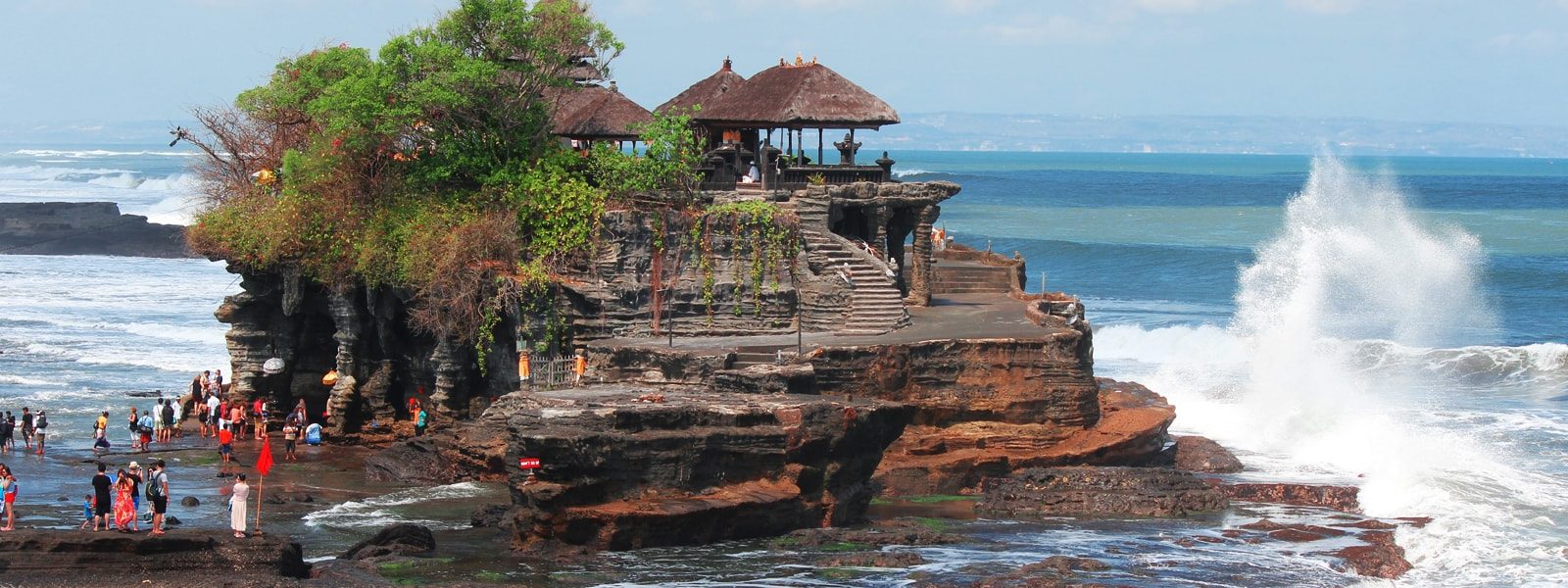When I think of Bali, one of the first images that comes to mind is Tanah Lot Temple—that iconic sea temple perched on a rocky outcrop, surrounded by crashing waves. Honestly, it’s one of those places that looks just as magical in real life as it does in all those photos you’ve probably seen. But there’s a lot more to it than just the picture-perfect view. After a couple of visits, I’ve learned a few things that I wish I’d known beforehand, so let me walk you through my experience and what you need to know before heading there.
The History and Spiritual Significance of Tanah Lot Temple
First, a bit of context because it helps to know what makes this place so special. Tanah Lot means “Land in the Sea” in Balinese, and the temple itself is one of seven sea temples built along the coast of Bali. The temple is dedicated to the sea gods and has been a place of worship for centuries. According to local legend, the temple was founded by Dang Hyang Nirartha, a revered Hindu priest, in the 16th century. It’s said that he saw the rock as a holy place and decided to build a shrine there to honor the sea gods.
One thing you’ll notice when visiting is that Tanah Lot Temple is not just a tourist attraction—it’s still a fully functional temple where locals come to pray and make offerings. That said, the temple itself is off-limits to non-worshippers, but you can still explore the surrounding areas, including the rocky shore and tide pools.
My First Visit to Tanah Lot Temple: What I Wish I’d Known
The first time I visited Tanah Lot, I was completely unprepared for the crowds. I went in the late afternoon, which is one of the busiest times because most people want to catch the sunset. Don’t get me wrong, the sunset here is stunning, but if you’re like me and not a fan of huge crowds, you might want to reconsider the timing. I found myself jostling with hundreds of other tourists, all trying to get the perfect photo of the temple as the sun dipped below the horizon. It was beautiful, sure, but also a bit chaotic.
If you’re looking for a quieter experience, try to visit earlier in the day—ideally in the morning. You won’t get that golden sunset glow, but you’ll have more space to walk around and take in the views. Plus, the temple looks equally impressive under the soft morning light.
How to Get to Tanah Lot Temple
Tanah Lot Temple is located about 20 kilometers (12 miles) from Denpasar and 45 minutes to an hour by car from popular areas like Seminyak or Canggu. If you’re staying in Ubud, it’ll take a bit longer, about an hour and a half. I’ve done the drive from both Seminyak and Ubud, and while it’s a bit of a trek, it’s absolutely worth it for the views.
When I first visited, I opted to rent a scooter, which was fun but a bit nerve-wracking because Bali’s traffic can be unpredictable, especially as you get closer to Tanah Lot Temple where the roads get narrow. The second time, I decided to play it safe and hire a Bali private driver. Honestly, I’d recommend going with the car and a driver option unless you’re really comfortable navigating Bali’s roads. Plus, it’s nice to sit back, relax, and take in the scenery along the way without worrying about directions.
There’s plenty of parking near the temple, but it does get crowded during peak hours, so be prepared to wait if you’re visiting in the late afternoon.
 Entrance Fees and What to Expect
Entrance Fees and What to Expect
There is an entrance fee to visit Tanah Lot Temple. As of my last visit, the fee was around IDR 75,000 (about $5 USD) for adults and IDR 50,000 for children. The fee gives you access to the temple grounds and surrounding areas, including the scenic walkways and viewpoints.
Once you pass through the entrance, you’ll walk through a market area where vendors sell everything from souvenirs to snacks and drinks. The market is pretty touristy, but it’s fun to browse, and I picked up a couple of handmade Balinese crafts here that were more affordable than I expected. If you’re a fan of souvenirs like me, it’s worth spending a few extra minutes checking out the stalls.
From the market, it’s a short walk to the main viewing areas. The path is well-paved, and there are several viewpoints where you can get great shots of the temple from different angles. I’d suggest walking around a bit before heading down to the shore—there’s a lot to see, and the views from above are just as stunning as those down by the water.
The Tide and Access to the Temple
One of the coolest things about Tanah Lot Temple is that, depending on the tide, you can actually walk across a rocky path to the base of the temple. When the tide is low, you’ll see a stream of people making their way across the rocks to get a closer look. I managed to do this on my second visit, and it felt pretty special to be so close to the temple itself. Just remember, the temple is off-limits unless you’re there to pray, but you can still get close enough to admire its structure and feel the sea spray on your face.
During high tide, the temple becomes completely surrounded by water, and the path is submerged. If you want to walk over to the temple, check the tide schedule beforehand. Most of the time, the tide goes out by the late afternoon, which is perfect if you’re planning to stay for sunset. I didn’t know this the first time, so I ended up missing out on the chance to get closer to the temple.
Sunset at Tanah Lot Temple: Is It Worth It?
Now, let’s talk about the sunset because that’s what most people come for, right? If you’re a fan of sunsets (and who isn’t?), Tanah Lot is one of the best places in Bali to catch a truly breathtaking one. The way the sun dips behind the temple and casts an orange and pink glow over the ocean is honestly a sight to behold.
That said, the sunset at Tanah Lot comes with a price—crowds. Like I mentioned earlier, it gets super busy in the late afternoon, especially around 5 or 6 p.m. when everyone is vying for the best spot to watch the sunset. If you don’t mind the crowds, it’s definitely worth staying for. I ended up finding a quieter spot off to the side, where I could watch the sun set in peace without too much commotion. You just have to be patient and willing to walk a bit further to escape the masses.
Other Things to Do Around Tanah Lot Temple
One thing I didn’t realize until my second visit is that Tanah Lot is surrounded by more than just the temple. There are a few other cool spots nearby that are worth checking out, especially if you’re already in the area.
Batu Bolong Temple: This smaller sea temple is just a short walk from Tanah Lot, and it’s perched on another rocky formation with a natural archway beneath it. It’s not as famous as Tanah Lot, but the views here are incredible, and it’s less crowded, making it a great spot for photography.
Tanah Lot Cultural Park: If you’re interested in learning more about Balinese culture, this small park offers traditional dance performances, including the famous Kecak Dance, in the evenings. I stayed for a performance once, and it was a nice way to end the day after watching the sunset. The mix of the dance, the setting sun, and the sea breeze made it a pretty magical experience.
Nearby Beaches: Tanah Lot is close to several beaches, like Kedungu Beach and Beraban Beach, where you can unwind after exploring the temple. These beaches are less crowded than Bali’s more famous ones, and they’re a great place to relax if you’re not ready to head back yet.
Tips for Visiting Tanah Lot Temple
Now that you know the basics, let me share a few practical tips that can help make your visit to Tanah Lot even better. These are things I learned after a couple of trips and some trial and error, so hopefully, they’ll save you some time and hassle.
1. Get There Early or Late
As I mentioned earlier, the crowds at Tanah Lot Temple can be intense, especially in the late afternoon when everyone flocks to catch the sunset. If you prefer a more peaceful experience, try to arrive either early in the morning or later in the evening, but not during prime sunset hours. If you arrive just after sunrise (around 6-7 a.m.), the place is almost deserted. You’ll have the temple to yourself, and it’s a completely different vibe compared to the bustling afternoon crowd.
Another option, which I personally enjoy, is visiting after sunset. Most of the tourists leave right after the sun dips below the horizon, but the area stays open for a while longer. You can enjoy the peaceful surroundings as the sky fades into twilight and the temple lights start to glow softly in the evening. It’s such a calming experience, and you still get those magical evening views without the stress of jostling with crowds.
2. Bring Sunscreen and Water
This might seem obvious, but believe me, you’ll regret it if you forget! There’s not a lot of shade around the temple grounds, and if you’re there in the middle of the day, the Balinese sun can be pretty relentless. I’ve made the mistake of forgetting sunscreen on one of my trips, and let’s just say my sunburn wasn’t exactly the souvenir I was hoping for.
Bring a hat, sunglasses, and definitely don’t forget water. You can buy drinks at the market near the entrance, but it’s always easier (and cheaper) to bring your own bottle. There are also a few places to sit and rest around the temple grounds, so it’s a good idea to stay hydrated while you’re exploring.
3. Dress Respectfully
Even though you can’t enter the temple itself unless you’re there to worship, it’s still important to dress respectfully when visiting. Tanah Lot Temple is a sacred site, so avoid wearing anything too revealing, like bikinis or super short shorts. When I visited, I noticed that most people wore casual clothes—think light cotton pants, dresses, or sarongs. If you don’t have a sarong, don’t worry! You can rent or buy one at the entrance, which is a nice way to support local vendors while showing respect for the temple.
4. Be Prepared for a Little Walking
Although Tanah Lot isn’t a strenuous hike by any means, there is a bit of walking involved. From the parking area to the temple, it’s a short walk (about 10-15 minutes), but if you plan to explore more of the area, you’ll end up doing quite a bit of walking. The paths are mostly paved, but they can get a bit uneven near the shore and rocky areas.
I usually wear comfortable sandals or sneakers, especially if I’m planning on walking around the tide pools or climbing over rocks to get a closer view of the temple. If you’re visiting during the rainy season (November to March), keep in mind that the paths can get slippery, so make sure your footwear has a good grip.
5. Respect the Local Culture
While Tanah Lot Temple is a popular tourist attraction, it’s still a place of worship for the Balinese people. I’ve seen some visitors forget this and get a little too focused on snapping photos, completely disregarding the locals who are there to pray. It’s important to be respectful—don’t climb on the rocks surrounding the temple, don’t use drones without permission, and give space to those who are there for spiritual reasons.
I remember feeling a bit self-conscious during my first visit because I wasn’t sure what was appropriate. Just follow the lead of the locals, and if in doubt, ask a guide or temple staff for advice. Most people are more than happy to help, and it’s better to ask than accidentally offend someone.
6. Photography Tips
Of course, you’re going to want to take photos at Tanah Lot Temple—it’s one of the most photogenic spots in Bali! But here’s the thing: because it’s so popular, it can be tough to get those Instagram-worthy shots without a bunch of other tourists in the background.
My go-to trick? Head to the smaller pathways and viewing areas around the temple. There are several hidden spots where you can capture the temple from unique angles. For example, I found a little trail that led me to a viewpoint higher up on the cliffside. It wasn’t crowded at all, and the view of the temple with the waves crashing below was amazing!
If you’re serious about photography, consider bringing a tripod for those longer exposure shots, especially if you’re staying for sunset. The golden hour light makes everything look magical, and with a tripod, you can get those smooth, blurred-water shots of the waves surrounding the temple.
 When’s the Best Time to Visit?
When’s the Best Time to Visit?
When it comes to timing your visit, Bali’s dry season (April to October) is generally the best. The weather is more predictable, the skies are usually clear, and the sunsets are just stunning. I’ve visited during both the dry season and the rainy season, and while there’s a certain charm to seeing Tanah Lot Temple in moody, overcast weather, you’re more likely to get those perfect views in the dry season.
That said, visiting in the rainy season (November to March) has its perks too. Fewer tourists brave the unpredictable weather, which means you might have a more peaceful experience. Just be prepared for some rain and possibly overcast skies. On one of my visits in January, I got caught in a brief downpour, but honestly, it added to the experience in a way. There was something mystical about seeing the temple through the misty rain, and it made for some unique photos that you wouldn’t typically see.
In the end, Tanah Lot Temple isn’t just about getting that perfect sunset shot (though, let’s be real, it’s definitely a highlight). It’s a place where you can feel the deep connection between Bali’s culture and nature. Whether you’re interested in the spiritual significance of the temple, the stunning ocean views, or just the experience of being in one of Bali’s most iconic locations, Tanah Lot Temple has something for everyone.
Personally, I’ll never forget my first visit—standing there on the cliffs, watching the sun set over the temple while the waves crashed against the rocks below. It’s one of those moments where everything just clicks, and you realize why this place is so special. I hope you have the chance to visit and experience it for yourself!
And hey, if you do go, don’t forget to stop by the nearby market for some pisang goreng and a cold coconut—you’ll thank me later!
Tanah Lot Temple location:



